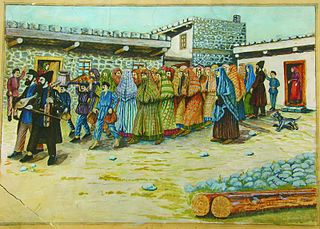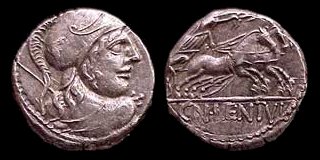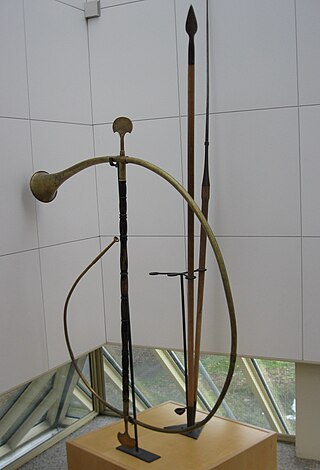
Lupercalia, also known as Lupercal, was a pastoral festival of Ancient Rome observed annually on February 15 to purify the city, promoting health and fertility. Lupercalia was also known as dies Februatus, after the purification instruments called februa, the basis for the month named Februarius.

Venus is a Roman goddess, whose functions encompass love, beauty, desire, sex, fertility, prosperity, and victory. In Roman mythology, she was the ancestor of the Roman people through her son, Aeneas, who survived the fall of Troy and fled to Italy. Julius Caesar claimed her as his ancestor. Venus was central to many religious festivals, and was revered in Roman religion under numerous cult titles.

In ancient Roman religion and mythology, Liber, also known as Liber Pater, was a god of viticulture and wine, male fertility and freedom. He was a patron deity of Rome's plebeians and was part of their Aventine Triad. His festival of Liberalia became associated with free speech and the rights attached to coming of age. His cult and functions were increasingly associated with Romanised forms of the Greek Dionysus/Bacchus, whose mythology he came to share.

The Aventine Hill is one of the Seven Hills on which ancient Rome was built. It belongs to Ripa, the modern twelfth rione, or ward, of Rome.

The Salii, Salians, or Salian priests were the "leaping priests" of Mars in ancient Roman religion, supposed to have been introduced by King Numa Pompilius. They were twelve patrician youths dressed as archaic warriors with an embroidered tunic, a breastplate, a short red cloak, a sword, and a spiked headdress called an apex. They were charged with the twelve bronze shields called ancilia, which—like those of the Mycenaeans—resembled a figure eight. One of the shields was said to have fallen from heaven in the reign of King Numa and eleven copies were made to protect the identity of the sacred shield on the advice of the nymph Egeria, consort of Numa, who prophesied that wherever that shield was preserved, the people would be the dominant people of the earth.

The pomerium or pomoerium was a religious boundary around the city of Rome and cities controlled by Rome. In legal terms, Rome existed only within its pomerium; everything beyond it was simply territory (ager) belonging to Rome.

Festivals in ancient Rome were a very important part in Roman religious life during both the Republican and Imperial eras, and one of the primary features of the Roman calendar. Feriae were either public (publicae) or private (privatae). State holidays were celebrated by the Roman people and received public funding. Games (ludi), such as the Ludi Apollinares, were not technically feriae, but the days on which they were celebrated were dies festi, holidays in the modern sense of days off work. Although feriae were paid for by the state, ludi were often funded by wealthy individuals. Feriae privatae were holidays celebrated in honor of private individuals or by families. This article deals only with public holidays, including rites celebrated by the state priests of Rome at temples, as well as celebrations by neighborhoods, families, and friends held simultaneously throughout Rome.

Ritual purification is a ritual prescribed by a religion through which a person is considered to be freed of uncleanliness, especially prior to the worship of a deity, and ritual purity is a state of ritual cleanliness. Ritual purification may also apply to objects and places. Ritual uncleanliness is not identical with ordinary physical impurity, such as dirt stains; nevertheless, body fluids are generally considered ritually unclean.

A flamen was a priest of the ancient Roman religion who was assigned to one of eighteen deities with official cults during the Roman Republic. The most important of these were the three flamines maiores, who served the important Roman gods Jupiter, Mars, and Quirinus. The remaining twelve were the flamines minores. Two of the minores served deities whose names are now unknown; among the others are deities about whom little is known other than the name. During the Imperial era, the cult of a deified emperor also had a flamen.

The Campus Martius was a publicly owned area of ancient Rome about 2 square kilometres in extent. In the Middle Ages, it was the most populous area of Rome. The IV rione of Rome, Campo Marzio, which covers a smaller section of the original area, bears the same name.

The suovetaurilia or suovitaurilia was one of the most sacred and traditional rites of Roman religion: the sacrifice of a pig, a sheep and a bull to the deity Mars to bless and purify land.
The Pons Sublicius is the earliest known bridge of ancient Rome, spanning the Tiber River near the Forum Boarium downstream from the Tiber Island, near the foot of the Aventine Hill. According to tradition, its construction was ordered by Ancus Marcius around 642 BC, but this date is approximate because there is no ancient record of its construction. Marcius wished to connect the newly fortified Janiculum Hill on the Etruscan side to the rest of Rome, augmenting the ferry that was there. The bridge was part of public works projects that included building a port at Ostia, at the time the location of worked salt deposits.

The Equirria were two ancient Roman festivals of chariot racing, or perhaps horseback racing, held in honor of the god Mars, one 27 February and the other 14 March.
An Agonalia or Agonia was an obscure archaic religious observance celebrated in ancient Rome several times a year, in honor of various divinities. Its institution, like that of other religious rites and ceremonies, was attributed to Numa Pompilius, the semi-legendary second king of Rome. Ancient calendars indicate that it was celebrated regularly on January 9, May 21, and December 11.

Lustratio was an ancient Greek and ancient Roman purification ritual. It included a procession and in some circumstances the sacrifice of a pig (sus), a ram (ovis), and a bull (taurus) (suovetaurilia). The name is the source of English "lustration".

In Ancient Rome the month of March was the traditional start of the campaign season, and the Tubilustrium was a ceremony to make the army fit for war. The ceremony involved sacred trumpets called tubae.

In ancient Roman religion and mythology, Mars is the god of war and also an agricultural guardian, a combination characteristic of early Rome. He is the son of Jupiter and Juno, and was pre-eminent among the Roman army's military gods. Most of his festivals were held in March, the month named for him, and in October, the months which traditionally began and ended the season for both military campaigning and farming.

In ancient Roman religion, the October Horse was an animal sacrifice to Mars carried out on October 15, coinciding with the end of the agricultural and military campaigning season. The rite took place during one of three horse-racing festivals held in honor of Mars, the others being the two Equirria on February 27 and March 14.

The Amburbium was an ancient Roman festival for purifying the city; that is, a lustration (lustratio urbis). It took the form of a procession, perhaps along the old Servian Wall, though the length of 10 kilometers would seem impractical to circumambulate. If it was a distinct festival held annually, the most likely month is February, but no date is recorded and the ritual may have been performed as a "crisis rite" when needed.

In ancient Roman religion, the Mamuralia or Sacrum Mamurio was a festival held on March 14 or 15, named only in sources from late antiquity. According to Joannes Lydus, an old man wearing animal skins was beaten ritually with sticks. The name is connected to Mamurius Veturius, who according to tradition was the craftsman who made the ritual shields (ancilia) that hung in the temple of Mars. Because the Roman calendar originally began in March, the Sacrum Mamurio is usually regarded as a ritual marking the transition from the old year to the new. It shares some characteristics with scapegoat or pharmakos ritual.












